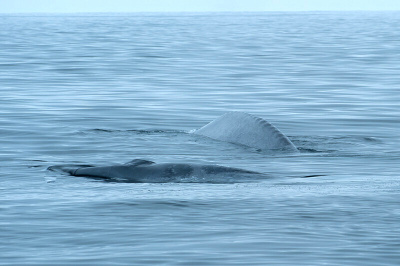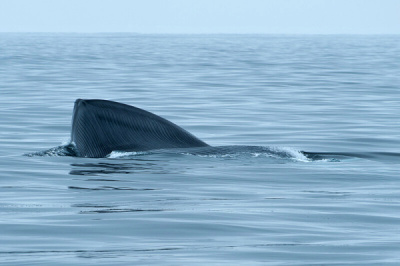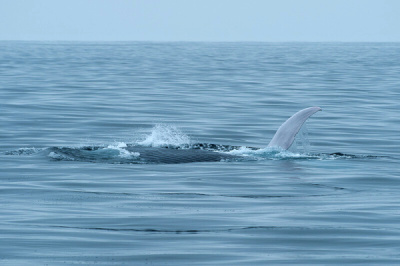The tail. Everybody loves “the tail.”
It’s the collective gasp from the crowd aboard any whale watching vessel when the observed whale decides it’s time to forgo the surface and dive deeper. Up its body arches and then, just before the hulking cetacean plunges downward, the fluke emerges from the water, dripping, waving, announcing its presence in a majestic display of form and beauty.
Here in Southern California, whale watching is a 12 month event since certain times of the year brings certain whales to our waters. Summertime, however, has proven especially delicious for whale watchers because the blues have come closer. For the past seven years, the giant blue whales have altered their normal feeding areas and opted to move closer to the coastline, making it easier for whale watching boats to bring folks out to them.
Why did they move closer? A yummier brand of their preferred prey, the shrimp-like krill, here? More predators out in those wilder waters? Scientists aren’t sure, but what they do know is that the summer of 2011 is setting up to be one of the most spectacular summers ever to observe the blue whale, The Largest Creature Ever To Live On The Face of Earth (cue: music sting).
On a recent whale watching trip out of Long Beach, whale watchers were treated to a rare sight – a mother and an estimated 4 to 5-month old calf, resting, feeding and frolicking in the waters only 7 miles from shore. On deck were staffers from the nearby Aquarium of the Pacific who were patiently answering questions about the blues, but who were also on board as part of an ongoing scientific observation about the whales.
Mother and baby. Notice the mom’s spine. She’s losing weight since she is nursing her baby with her super-rich, 35-50 percent milk fat. By contrast, human mom’s milk is a mere 2 percent.
For three years the Aquarium has partnered with Cascadia Research Collective based in Olympia, Washington, providing biologists with data, photos and notes regarding the endangered blue whales that make Southern California their home for the summer months. “We’re out here on their daily whale watching trips, twice a day,” says Kera Mathes, the aquarium’s boat program coordinator who’s handy with a camera, has an eye for the whales and was instrumental in getting the partnership off the ground.
Mathes directed a nearby intern with a clipboard how to chart the data from this sighting – how long the pair were above water, what they were doing, estimates on size and if these whales have been previously recorded. Cascadia has a huge data bank of blue whales from up and down the coastline and what Mathes and company see out here will be added to that information.
Currently, about 2-3,000 blue whales are thought to be in the Pacific waters, but relatively little is known about these mysterious swimmers, despite the fact that they are The Biggest Thing Ever On This Planet (cue: a higher musical sting). It’s not known exactly where they go in the wintertime and their migration paths are very much a blue whale secret.
Back on the boat, after the cow and her calf was spotted, the captain turned the engines off allowing us humans could hear the blow of the blue whale, that powerful breathe of air that translates into a 30-foot plume of mist.
Admire from a distance. Lots of bacteria in that spray.
But today was a trifecta for whale watchers. Not only was a cow/calf pair spotted, but the baby dived, revealing its fluke, another very rare occurrence indeed which elicited big sighs and low cries from all on deck.
Rounding out the “Did I Really Just See That?” the pair was seen lunge feeding at the surface which gave those on deck a good view of huge pleats under their mouths. (Lunge feeding is when whales on the surface open their mouths wide and take in prey and water; then they close their mouths and filter out the prey using their ginormous tongues to squeeze the water through their baleen plates. All that’s left in their mouths is one big tasty gulp.)
Opening up…..
…and rolling over with a flipper wave.
It’s hard not to get emotional when you see one of these creatures up close; equally, it’s hard not to feel a little perturbed by local cargo ships that are infringing on the whale’s krill-eating territory and baby-raising nurseries. Since the whales have “relocated” their feeding grounds, the ships have not altered their shipping lanes. “That’s why this research we are doing with Cascadia is so important,” says Mathes. “We will have evidence and data that shows we need to move the ships a mile or two away from the area to keep them safe.”
No blue whale/cargo boat accidents have occurred this year – so far.
On the ride back to port, a pod of 100 common dolphins swam merrily alongside the vessel – another glorious sight. But then, once in the harbor, discarded plastic bags, soda bottles and streaks of oil on the waters’ surface disrupted those good images. (Oh, come on guys! Really??) But interruptions aside, the image of the tail, the baby tail, the lunge feeding and the two great creatures living in our waters is a great motivator for change. Because, really, If We Humans Are Not Going To Change Things Now, Then When? (Cue: indecisive music sting).
For more information about whale watching cruises offered daily by the Aquarium of the Pacific and Harbor Breeze Cruises click here. Trips depart daily at 11:30 a.m. and 3 p.m. Combo tickets, which include a whale cruise and aquarium admission, are available on site at the aquarium; admission is $63.95 for adults, $55.95 for seniors and $39.95 for children.
— Story by Brenda Rees; photos by Martha Benedict






